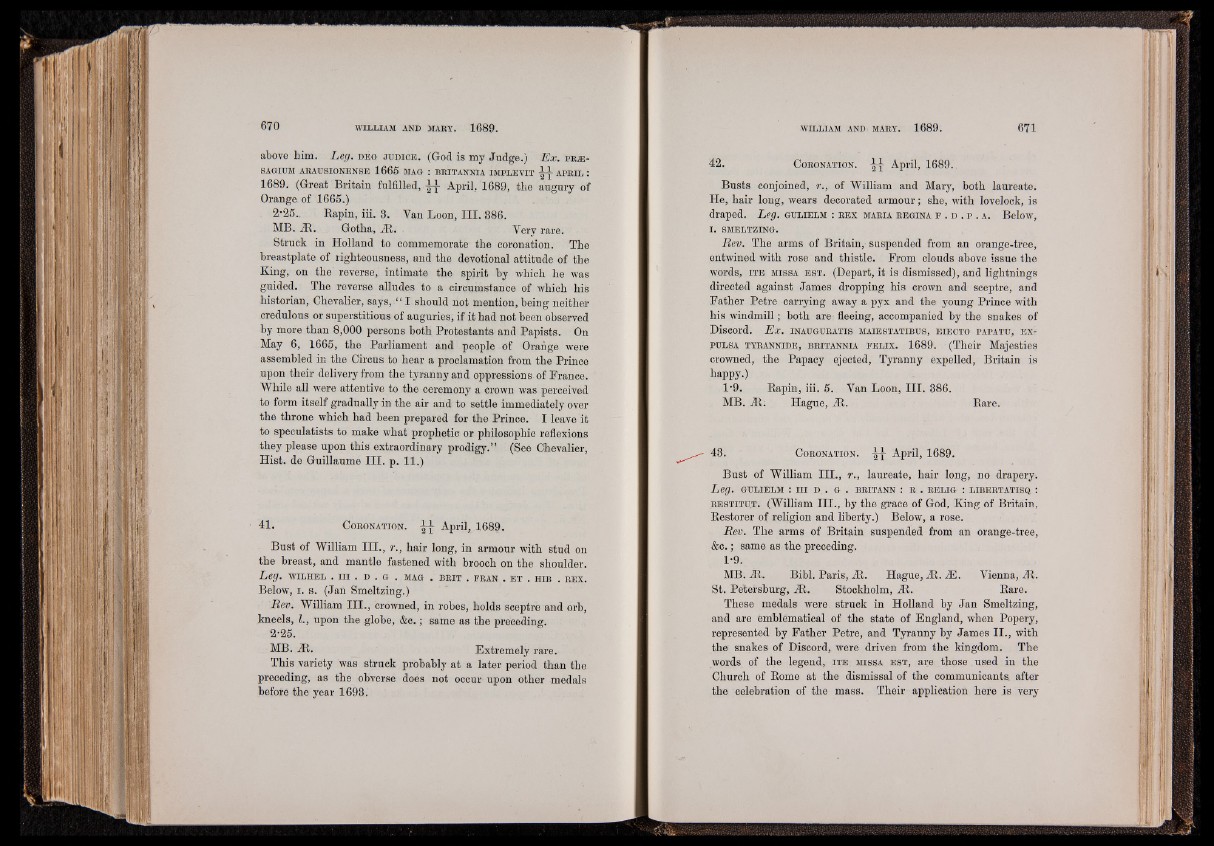
above him. Leg. d e o j u d ic e . (God is my Judge.) Ex. PEvE-
SAGIUM ABAUSIONENSE 1665 MAG : BEITANNIA IMPLEVIT APEIL :
1689. (Great Britain fulfilled, April, 1689, the augury of
Orange of 1665.)
2*25.. Rapin, iii. 3. Van Loon, III. 386.
1MB. At. Gotha, .1 t . , Very rare.
Struck in Holland to commemorate the coronation. The
breastplate of righteousness, and the devotional attitude of the
King, on the reverse, intimate the spirit by which he was
guided. The reverse alludes to a circumstance of which his
historian, Chevalier, says, “ I should not mention, being neither
credulous or superstitious of auguries, if it had not been observed
by more than 8,000 persons both Protestants and Papists. On
May 6, 1665, the Parliament and people of Orange were
assembled in the Circus to hear a proclamation from the Prince
upon their delivery from the tyranny and oppressions of France.
While all were attentive to the ceremony a crown was perceived
to form itself gradually in the air and to settle immediately over
the throne which had been prepared for the Prince. I leave it
to speculatists to make what prophetic or philosophic reflexions
they please upon this extraordinary prodigy.” (See Chevalier,
Hist, de Guillaume III. p. 11.)
41. C o eo n a t io n . April, 1689.
Bust of William III., r., hair long, in armour with stud on
the breast, and mantle fastened with brooch on the shoulder.
Leg. WILHEL . I l l . D . G . MAG . BEIT . FEAN . ET . HIB . EEX.
Below, i. s. (Jan Smeltzing.)
Rev. William III., crowned, in robes, holds sceptre and orb,
kneels, I., upon the globe, &c.; same as the preceding.
2-25.
MB. At. Extremely rare.
This variety was struck probably at a later period than the
preceding, as the obverse does not occur upon other medals
before the year 1693.
42. C o eo n a t io n . April, 1689.,
Busts conjoined, r., of William and Mary, both laureate.
He, hair long, wears decorated armour; she, with lovelock, is
draped. Leg. g u l ie lm : e e x mae ia e e g in a f . d . p . a. Below,
i . sm e l t z in g .
Rev. The arms of Britain, suspended from an orange-tree,
entwined with rose and thistle. From clouds above issue the
words, it e m is sa e s t . (Depart, it is dismissed), and lightnings
directed against James dropping his crown and sceptre, and
Father Petre carrying away a pyx and the young Prince with
his windmill; both are fleeing, accompanied by the snakes of
Discord. Ex. in a u g u e a t is m a ie s t a t ib u s , e ie c t o pa pa tu , e x -
pu l sa ty e a n n id e , b e it a n n ia f e l ix . 1689. (Their Majesties
crowned, the Papacy ejected, Tyranny expelled, Britain is
happy.)
1’9. Rapin, iii. 5. Van Loon, III. 386.
MB. At. Hague, At. Rare.
43. C o eo n a t io n . April, 1689.
Bust of William IH., r., laureate, hair long, no drapery.
Leg. g u l ie lm : i i i d . g . b e it a n n : e . e e l ig : l ib e b t a t is q :
b e s t it u t . (William III., by the grace of God, King of Britain,
Restorer of religion and liberty.) Below, a rose.
Rev. The arms of Britain suspended from an orange-tree,
&c.; same as the preceding.
1-9.
MB. At. Bibl. Paris, At. Hague, At. AS. Vienna, At.
St. Petersburg, At. Stockholm, At. Rare.
These medals were struck in Holland by Jan Smeltzing,
and are emblematical of the state of England, when Popery,
represented by Father Petre, and Tyranny by James II., with
the snakes of Discord, were driven from the kingdom. The
words of the legend, it e m is sa e s t , ai;e those used in the
Church of Rome at the dismissal of the communicants after
the celebration of the mass. Their application here is very